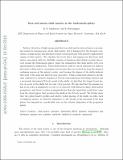Seen and unseen tidal caustics in the Andromeda galaxy
Author(s)
Sanderson, Robyn Ellyn; Bertschinger, Edmund
DownloadBertschinger Seen and unseen 1006.4165v2.pdf (957.4Kb)
OPEN_ACCESS_POLICY
Open Access Policy
Creative Commons Attribution-Noncommercial-Share Alike
Terms of use
Metadata
Show full item recordAbstract
Indirect detection of high-energy particles from dark matter interactions is a promising
avenue for learning more about dark matter, but is hampered by the frequent coincidence
of high-energy astrophysical sources of such particles with putative high-density
regions of dark matter. We calculate the boost factor and gamma-ray flux from dark
matter associated with two shell-like caustics of luminous tidal debris recently discovered
around the Andromeda galaxy, under the assumption that dark matter is its own
supersymmetric antiparticle. These shell features could be a good candidate for indirect
detection of dark matter via gamma rays because they are located far from the primary
confusion sources at the galaxy’s center, and because the shapes of the shells indicate
that most of the mass has piled up near apocenter. Using a numerical estimator specifically
calibrated to estimate densities in N-body representations with sharp features and
a previously determined N-body model of the shells, we find that the largest boost factors
do occur in the shells but are only a few percent. We also find that the gamma-ray
flux is an order of magnitude too low to be detected with Fermi for likely dark matter
parameters, and about 2 orders of magnitude less than the signal that would have come
from the dwarf galaxy that produces the shells in the N-body model. We further show
that the radial density profiles and relative radial spacing of the shells, in either dark
or luminous matter, is relatively insensitive to the details of the potential of the host
galaxy but depends in a predictable way on the velocity dispersion of the progenitor
galaxy.
Date issued
2010-11Department
Massachusetts Institute of Technology. Department of Physics; MIT Kavli Institute for Astrophysics and Space ResearchJournal
Astrophysical Journal
Publisher
IOP Publishing
Citation
Sanderson, R.E. and E. Bertschinger. "Seen and unseen tidal caustics in the Andromeda galaxy." Astrophysical Journal, v.725, no.2, December 2010, pp.1652-1675. © 2010 American Astronomical Society.
Version: Author's final manuscript
ISSN
0004-637X
1538-4357
Keywords
High Energy Astrophysical Phenomena